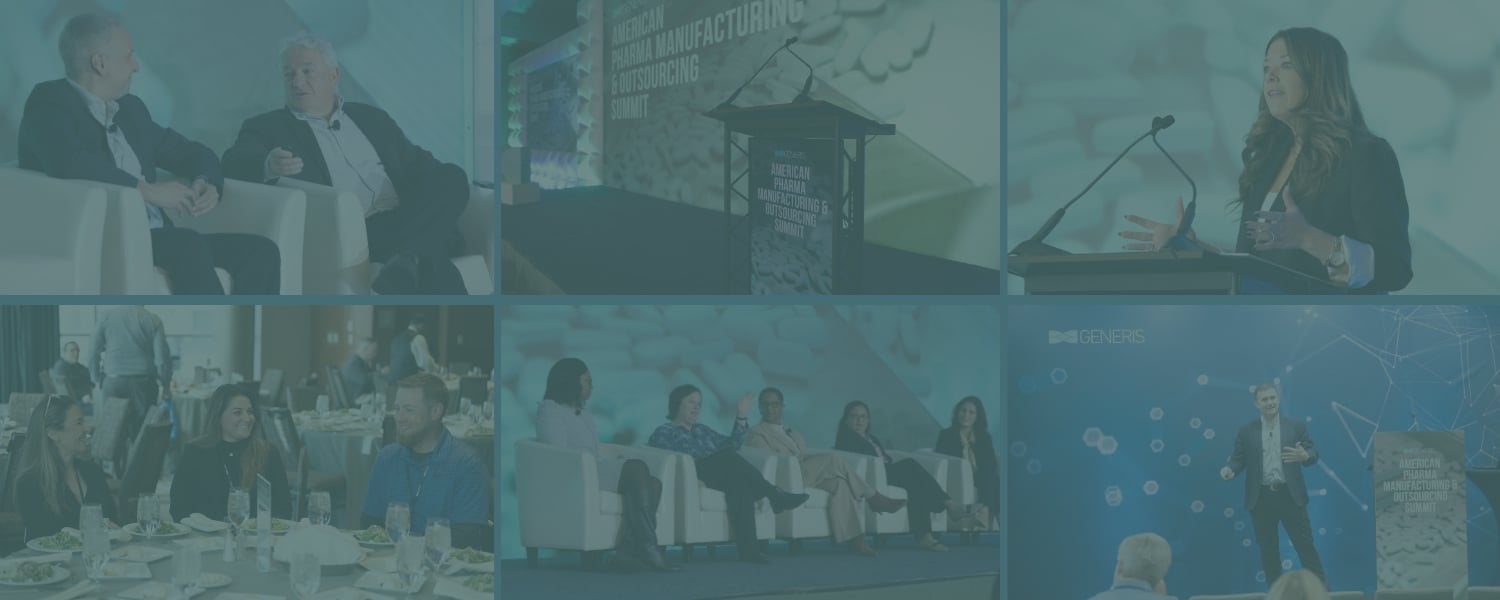As the 11th annual American Biomanufacturing Summit approaches, we’re excited to highlight some of the industry’s most influential leaders who will be sharing their insights on the future of biomanufacturing.
One of those key voices is Christopher Grail, SVP and Head, Global Pharma Engineering and Maintenance Excellence Lead at Bayer. With decades of experience in engineering, operational efficiency, and biomanufacturing innovation, Christopher is at the forefront of driving transformative change in the industry.
We had the opportunity to sit down with Christopher to discuss his career, key industry trends, and what attendees can look forward to at the 2025 American Biomanufacturing Summit.
.jpg?width=238&height=323&name=Christopher%20Grail%20(1).jpg)
Can you introduce yourself, and share more about your career journey leading up to your current role as the SVP and Head, Global Pharma Engineering and Maintenance Lead at Bayer?
I’m originally from the UK and began my career in engineering with the British Royal Navy. Over the years, I’ve had the opportunity to work with several pharmaceutical companies across different locations around the world. My journey has taken me through operations, mergers and acquisitions, and ultimately back to my core passion—engineering.
For the past six years, I’ve been with Bayer, where I now lead Global Pharma Engineering & Maintenance Excellence. In this role, I oversee all activities related to engineering, maintenance excellence, investment, sustainability, and health & safety for our pharmaceutical organization. It’s been an incredible journey, and I’m excited to share my insights at the upcoming summit.
What strategies have you used to reduce the carbon footprint of manufacturing processes at Bayer?
One of the most important aspects of reducing the carbon footprint in manufacturing is measurement—it’s a fundamental starting point. If you don’t know how much energy and resources you’re using, you can’t effectively manage them.
That’s why one of the key strategies I’ve implemented is introducing simple metering processes to provide visibility into our resource consumption. Once people can actually see the costs and environmental impact, it sparks engagement. It’s amazing how awareness alone can drive action—when people realize that reducing waste is not only good for the environment but also for cost efficiency, it creates a powerful incentive.
Beyond measurement, it’s also about smart facility design and operations. When we build and manage our facilities the right way, we not only maximize production uptime but also ensure we’re meeting our sustainability targets. In the end, it’s about finding that balance—delivering efficiency while making a meaningful environmental impact.
What emerging technologies or trends do you think will shape the future of sustainable waste and water management?
Water is a major focus for us. The first step—just like with energy management—is measurement. Understanding exactly how much water we’re using allows us to implement efficient systems that minimize consumption.
One key area we’re exploring is disposable technologies and minimal wash cycles, which help significantly reduce water usage. Instead of relying on gallons and gallons of water, we’re finding ways to use only what’s necessary while ensuring quality and compliance.
Another critical aspect is water recovery. Many of our older plants have large-scale wastewater management systems, and we’re looking at how emerging technologies can modernize these processes.
By leveraging advanced water treatment and recycling methods, we can reuse water effectively within our production systems—helping us keep the environment clean while improving efficiency.
What are some of the biggest challenges companies face when transitioning to eco-friendly production systems?
The primary focus in production is always on the product and the patient—and rightly so. However, one of the biggest challenges in transitioning to eco-friendly production systems is ensuring that sustainability is integrated from the very beginning, rather than being an afterthought. If sustainability considerations come too late in the process, it becomes much harder to implement them effectively.
That’s why stakeholder management is critical at every stage—from the initial planning phase to execution and long-term operation. It’s important to shift the perception that sustainability is simply an added cost. Some may see it as an extra financial burden, but in reality, it’s about the total cost of ownership and the long-term impact of the footprint we leave behind.
A sustainable facility and production process often operates more efficiently and cost-effectively over its lifecycle. While there are inevitable upfront costs, the long-term benefits—both financially and environmentally—far outweigh them. “The key is understanding sustainability as an investment, not just an expense”.
What key factors must be considered when designing a sustainable manufacturing facility?
Designing a sustainable manufacturing facility isn’t a one-size-fits-all approach—it depends heavily on location-specific factors. Where you build—whether it’s a specific country, region, or climate zone—plays a crucial role in determining what sustainability strategies will be most effective.
For example, leveraging natural resources like free cooling or free heating from the environment can significantly improve efficiency. If you’re in a sunny location like California, investing in a solar park might be an excellent option. However, in Germany, where sunlight levels are lower, a solar park may not provide the same return on investment.
The key is to prioritize sustainability solutions that are both efficient and practical for the specific environment. Simply implementing technology with a “green label” won’t guarantee success if it doesn’t fit the location or operational needs. Without stakeholder buy-in, you won’t see the expected returns or sustainability benefits.
Ultimately, success comes from aligning sustainable design with regional conditions, ensuring that every initiative delivers real, measurable value—both environmentally and operationally.
How do you measure the success of sustainability initiatives in facility design and operations?
One of the most visible indicators of sustainability success is LEED certification—many of our facilities have achieved this standard.
It’s a clear sign that sustainability was a core focus in the design process, not just an afterthought. Trying to retrofit sustainability measures after a facility is built is far more challenging, which is why it’s critical to integrate them from the start.
Beyond certification, measuring sustainability success comes down to tracking resource efficiency. A key metric is how well we link production outputs with waste reduction—ensuring that we not only reuse materials but, more importantly, reduce overall consumption. This means lowering electricity usage, minimizing water consumption, and cutting down on plastic consumables.
“For me, the priority is always reduction first—using fewer resources from the outset. Then, the focus shifts to reuse, finding ways to optimize and repurpose materials wherever possible”.
By taking this approach, we can drive meaningful sustainability improvements in both facility design and daily operations.
I understand you are going to go into a deeper dive during your case study, can you give us a preview of some of Bayer’s engineering innovations driving sustainability?
.jpg?width=447&height=335&name=Berkeley%20Site%203%20(1).jpg)
We’ve really challenged ourselves to do things differently, and while that comes with its own set of hurdles—especially the perception that sustainability adds cost—it’s important to recognize that in the long run, these innovations deliver significant value.
One of our most exciting projects is in California, where we’ve built the first all-electric manufacturing facility for cell therapy. The way we designed this building is truly innovative, and it’s not only setting new sustainability benchmarks but has also been nominated for a ISPE Facility of the Year Award. Beyond its energy efficiency, this facility is also notable for its multifunctional use, making it a model for future designs.
Across our European plants, we’re implementing ground source heating, while in other locations, we’re leveraging traditional solar panel installations. Each facility is unique, so we tailor our engineering strategies to fit both the region and the specific production processes involved.
On a broader scale, we’re constantly exploring ways to reduce resource consumption, which often means upgrading equipment and optimizing systems—whether it’s heating, cooling, compressed air, or other utilities. These engineering upgrades may seem small, but they add up to major efficiency gains over the equipment life cycle.
I’ll be sharing more details and real-world examples during my case study presentation at the American Biomanufacturing Summit—looking forward to showing you exactly how and where we’ve made these innovations happen!
What are you most looking forward to about the American Biomanufacturing Summit?
I’m really looking forward to presenting at the summit and sharing some of my experiences with industry peers. But more than that, I’m excited for the conversations—I hope attendees come with questions, fresh perspectives, and new ideas that we can all learn from.
It’s always great to reconnect with familiar faces and meet new professionals who are just as passionate about advancing biomanufacturing. This summit is an incredible opportunity to exchange ideas, spark innovation, and ultimately drive a better future—not just for our industry but for the patients we serve every single day.
Christopher Grail’s session at the American Biomanufacturing Summit is a must-attend for professionals looking to gain practical insights into engineering excellence, operational efficiency, and the future of maintenance strategies in biomanufacturing.
Taking place April 15-16, 2025, at the Hyatt Regency San Francisco Airport, this summit brings together top executives, thought leaders, and industry pioneers to explore the latest trends, technologies, and best practices shaping the biomanufacturing landscape.
Don't miss your chance to connect with Christopher Grail and other top leaders in the field! Secure your spot today and be part of the conversation shaping the future of biomanufacturing.
Stay tuned for more speaker spotlights as we gear up for an incredible event!
%20(1).png?width=773&height=112&name=Generis%20Logo%20full%20Colour%20(Large)%20(1).png)


-Nov-13-2025-01-18-02-9699-PM.png)
-2.png)